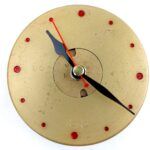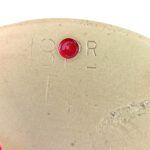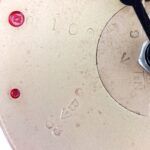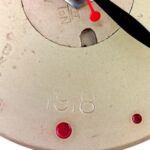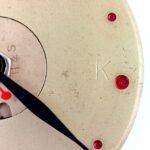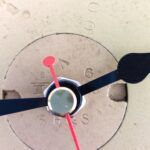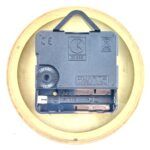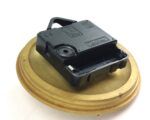*British, WW1, Remembrance 18 Pounder Shell Case Clock, Dated 1918, Made by K – Kynoch Factories, Imperial Chemical Industries Ltd., Birmingham*
Approximate measurements: 10.5cm diameter, 3cm depth
Markings:
18 Pr – (18 Pounder)
I – (Mark 1)
Lot 100
B War Arrow 18 – (B – Inspection Mark, 1918)
1918 – (1918)
K – (Manufactured by Kynoch Factories, Imperial Chemical Industries Ltd., Birmingham, England)
Primer Marked:
No 1/III
S.H&S. (Manufacturer)
6/16 – (June 1916)
A wonderful WW1 Souvenir – this 18 Pounder shell case has been made into a wall mounted clock, with a quartz battery operated mechanism, depressed red dots have been added for the 5 and 15 minute markers. The shell case was made by Kynoch Factories, Imperial Chemical Industries Ltd., Birmingham, England in 1918.
Background 18 Pounder
The British 18-pounder (84mm) was an anti-personnel projectile designed to carry low-explosive (HE) and shrapnel payloads, spin-stabilized for accuracy. It was highly effective against troops in the open, including those manning guns without protective shields. At the start of World War I, the British Army’s field guns—primarily the 13-pounder and 18-pounder—were equipped exclusively with shrapnel projectiles, with field guns outnumbering howitzers (5-inch and 4.5-inch) by a 3:1 ratio. The 18-pounder’s shrapnel shell contained 374 small spherical bullets. A time fuse was set to detonate the projectile mid-air just in front of the target, which would eject the nose and send the bullets forward in a shotgun-like cone, effective up to 300 yards from the explosion. With a theoretical rate of 20 rounds per minute, the 18-pounder could release 7,480 bullets per minute, offering a longer effective range than machine guns. Expert artillery gunners from the Regular Army were highly skilled in using shrapnel fire to provide accurate, close support for advancing infantry.
*Condition*
Good used condition. Please see photographs as part of the condition report.
JAQGE#411125_1895194463









